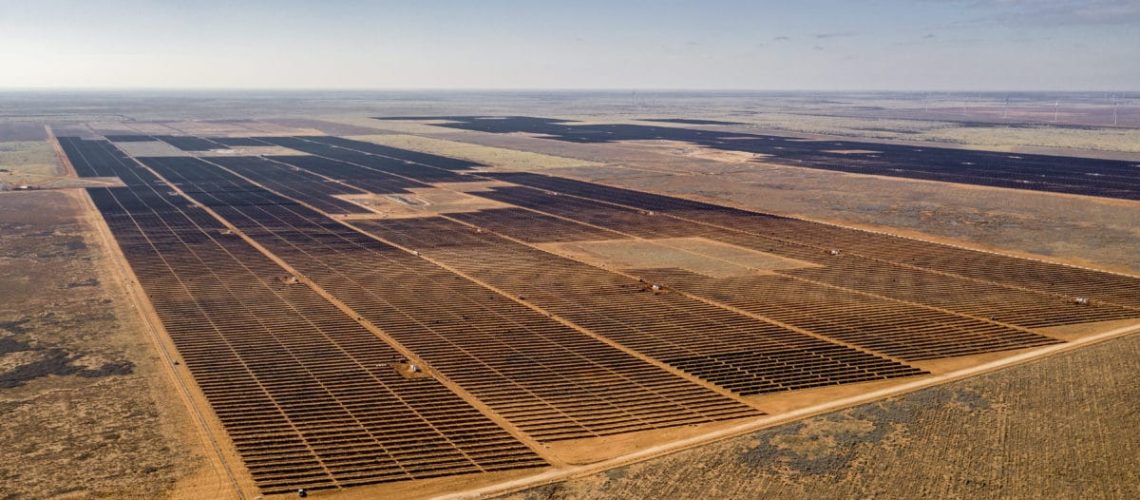Texas grid operator ERCOT is enabling rapid growth in solar and wind capacity through an interconnection process known as “connect and manage.” That approach could be used across the U.S. with modifications, according to a new study.
The Texas grid operator ERCOT interconnected 6 GW of renewables in 2021—about three times as much as the nation’s largest grid operator PJM—and outperformed PJM by a wider margin in 2022, according to data compiled by S&P Global Market Intelligence.
ERCOT’s process “is so much faster than some of the other processes,” Brattle Group Principal Johannes Pfeifenberger has said, because ERCOT “pretty much” follows a process known as “connect and manage,” as opposed to the “invest and connect” approach followed by other U.S. grid operators.
Executives from Clearway Energy Group and Enel North America have called for combining the connect-and-manage approach with comprehensive regional transmission planning to efficiently interconnect large-scale renewables and storage.
Now Tyler Norris, a former Cypress Creek Renewables executive, has tackled the question of just how the connect-and-manage approach could be used in the rest of the U.S., in a paper published by the Nicholas Institute for Energy, Environment and Sustainability at Duke University. Norris is a Ph.D. candidate at Duke researching electric power systems.
Connect and manage is well-suited for ERCOT, with its energy-only electricity market, Norris says, and can be adapted for use elsewhere in the U.S. where electricity markets have a capacity market alongside an energy market.
To describe connect and manage, Norris first compares it to the Network Resource Interconnection Service (NRIS) process that is typically used for interconnection requests for large-scale renewables projects outside of ERCOT.
NRIS requires a proposed generator to be able to deliver to load during severe grid conditions, such that it can be designated as a capacity resource and contribute to resource adequacy requirements, Norris says. NRIS studies often identify the need for significant grid upgrades to relieve grid constraints, so this approach has been termed “invest and connect.” The grid upgrades required “can often make generators financially unviable and delay interconnection by years,” Norris says.
Some project developers opt for an alternative interconnection service known as Energy Resource Interconnection Service (ERIS), which Norris says is less likely than NRIS to require grid upgrades. Generators with ERIS service, however, are more likely to be curtailed during emergency conditions, “which introduces greater uncertainty for project revenue forecasts.”
In ERCOT, which is currently an energy-only market without capacity compensation, essentially “all generators are treated like ERIS and there is no NRIS option,” Norris says. With fewer network upgrades to slow interconnection, generators can interconnect “much more quickly,” Norris says, “in exchange for bearing more curtailment risk and not receiving capacity compensation.”
Improving ERIS
Because ERIS is the connect-and-manage approach in a nutshell, Norris examines how ERIS service could be improved across the U.S.
He notes that Commissioner Allison Clements with the Federal Energy Regulatory Commission (FERC) encouraged further consideration of how to streamline ERIS, and said FERC could address this topic in a rulemaking, in her concurrence to FERC Order 2023.
Curtailment risk
Norris evaluates several possible approaches to reducing curtailment risk under ERIS, including flexible operation of solar plants and alternative compensation methods for power purchase agreements.
A hybrid approach
Storage is a capacity resource, yet would not be compensated for its substantial capacity value under ERIS. With increasing amounts of hybrid capacity (renewables-plus-storage) waiting in interconnection queues, Norris considers ways to enable project developers to make use of both ERIS and NRIS approaches. Potential solutions, he says, include preserving the option for ERIS interconnection customers to pursue NRIS; allowing a hybrid developer to submit a separate NRIS application limited to the nameplate rating of the storage; or developers pursuing standalone storage over paired storage.
Linkages
Noting that a FERC order is pending to improve regional transmission planning and cost allocation, Norris says that “proactive transmission planning is equally important as improved ERIS-based standards”–echoing the call from Clearway Energy Group and Enel North America executives. In areas without a regional grid operator, Norris also makes a case for “rationalizing the relationship” among interconnection, transmission planning, and competitive procurement.
Backstory
Norris said he came to the topic of connect and manage largely through his involvement in North Carolina’s 2022 Carbon Plan proceeding, in which he testified on behalf of the Clean Power Suppliers Association and “collaborated closely” with The Brattle Group to develop an alternative resource plan. During that work, he said, “it became increasingly apparent how the existing invest-and-connect approach is limiting interconnection rates.” He describes the disadvantages of invest and connect in his paper.
Norris’s paper is titled “Beyond FERC Order 2023: Considerations on Deep Interconnection Reform.”





